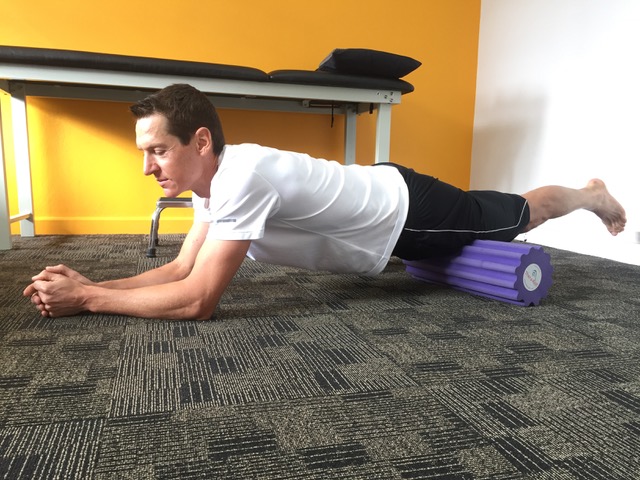Stretching and rolling your way out of a posterior pelvic tilt
A foam roller has two big purposes, the first is as a form of self massage to reduce muscle tension and alleviate tension through hard working muscles. The second and what I believe is more important is how using a foam roller can neurologically release, stimulate or wake up a targeted muscle. This primes the muscle for firing and assist in getting the muscle and body ready for the stretch or strength session ahead.
The roller can be used for as little as 15-30” on each muscle group before a stretch. When it comes the stretch though, think of the purpose. Here you are trying to lengthen a chronically tight muscle to change a pattern. This means hold the stretch. 90” to 180” is a great targeted time. If you are using stretching to change a muscle pattern you need to give the muscle ample time to unwind. So lean into it…..
2.1. Psoas foam roller, release and stretch (0:35)
This is the most influential muscle in the entire posterior pelvic tilt debate. Posas tension can trigger disc problems, lower back pain and sciatica.
Roller work for the psoas is best done in the army crawl position, once done well it can open up huge areas of body tension and previous restriction exposing a whole new world of motion.
Stretching from here can be as simple as “taking a knee.” Lean into it so that you can feel the release. Feel free to play with the positioning of the back foot in the stretch or even the ball in the roller release. This is such a big and powerful muscle, a small change in your set up or position could really benefit.
2.2. Glutes foam roller, release and stretch (1:55)
One of the key evolutionary muscles that took us from walking around on all fours to being upright. Yet many people struggle and say I just can’t engage my gluts, or my gluts don’t work. Perhaps it’s because they are switched off or we have spent too much time hunched over sitting, stuck in a posterior pelvic tilt….
Start sitting on a roller, aiming to only really work one glut at a time, roll the body around feeling into the tension.
As for stretching the gluts, lying on your back, bend the knee of the leg you wish to stretch & pull it across the body towards the floor. The big trick here is to emphasise going long & trying to lengthen the body as far as possible.
2.3. Lower and upper back foam roller and extension stretch (3:12)
For the lower spine rolling is a great way to unlock and alleviate tension.
Keeping the arms crossed over your chest, with the roller perpendicular to your back. Roll the lower back up and along the roller and don’t worry too much about doing your entire back at one time. Rolling smaller, controlled rolls can keep the movement more concentrated and specific.
As for an extensor stretch, lying face down with palms directly under your shoulders and keep your hips pressed flat to the floor. Press the top half of your body up, trying to curl the vertebrae one at a time. Here you are deliberately feeling for the stretch right at the lower back. The height is not the omportant thing, the feeling matters so much more so feel for the stretch through the lower spine, it may help to keep the hips pushed towards the floor.
2.4. Quadricep foam roller and stretch (4:45)
The quadriceps are a big powerful muscle that act almost as an extension of the hip flexor. If your hip flexor is tense and tight then there is a good chance of having quadricep issues too. Tightness here can cause a myriad of knee issues especially as the knee cap literally lives inside the quadriceps tendon.
Back in the army crawl position, really working through one quadriceps at a time works the best. Feel free to roll around though as this strong, wide muscle can and should be released from various angles. As for stretching the quadriceps, long and slow is again required, pulling the foot back towards the gluts is the easiest way, feeling for the big muscle on the front of the legs to relax.
2.5. Hamstring foam roller and stretch (6:11)
The opposite of the quadriceps, the hamstrings are a very large muscle group on the back of the leg. These anchor the pelvis or hips to the knee. As such in a posterior pelvic tilt these muscles can start to become inactive. Roller work can really awaken these up and help shift away from the posterior pelvic tilt.
Aim to roll one leg at a time, crossing one foot over the other. Don’t feel as though you have to do the entire muscle, just focusing on the top or bottom at one time, or conversely just rolling the leg in or out can really help to target the release.
When stretching, bend forwards slowly but steadily, trying to rotate through the hips and feel into the muscle. Whether using the hands around your calves, or feet, find an anchor point that you can hold onto and pull into the stretch.
Missed mobilising for a Posterior Pelvic Tilt? You can find Part 1 here.
If you’re ready to move onto Part 3, Strengthen to correct a posterior pelvic tilt, click here.

